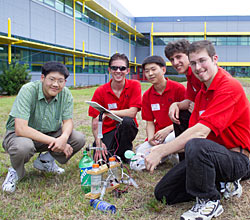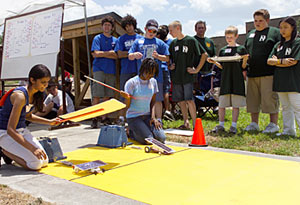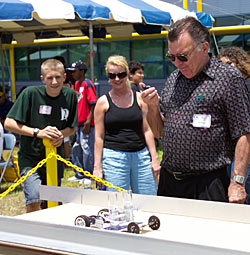
|
|
July 2006 |
Student
Hydrogen Sprint Competition “Takes the Green Flag” This year’s Hydrogen Sprint competition at FSEC brought more than 40 students from around the Southeast with nine hydrogen vehicles to compete in races and activities at the center in May. The students designed and built model-sized hydrogen vehicles that were powered by hydrogen fuel cells which used the energy from sunlight to break apart water into hydrogen and oxygen.
FSEC’S Susan Schleith, who directs this annual event, noted that “The hundreds of students who took part in this exciting program are putting their problem-solving skills to work by designing, building and racing model-size alternative energy vehicles to demonstrate the technology. They really do better every year by building on their knowledge and experience.” In this year’s event, a team from Edgewood Jr/Sr High School in Merritt Island even built their own hydrogen refueling station The students got a great deal of praise from the other students and teachers for their ingenious refueling station which eliminated the need for water storage tanks on the vehicle. This allowed them to lighten their vehicle substantially – a prime goal in the design of a racing vehicle. As a result, vehicle speeds nearly doubled over last years’ times. Schleith pointed out that “It’s very gratifying to see students using their skills to address energy issues on a small scale, knowing that those same skills will be used as future decision-makers. It’s what we like to do in all of our FSEC educational programs. Running the cars in the race is only part of the event. The students get so much out of the planning design, teamwork and decision-making all through the process of preparing for race day.”
The event is part of the EnergyWhiz Olympics, an annual competition that features alternative fuels and includes the Junior Solar Sprint and the Middle School Science Bowl Hands-On Hydrogen competition as well as the Hydrogen Sprint. More than 300 students participated in these events. The Junior Solar Sprint is a hands-on competition for middle school students in grades 6 through 8. Students work in teams to design, build and race model-size, solar-powered vehicles. Awards are given based on vehicle design, quality of craftsmanship, innovation and vehicle speed.
The High School Hydrogen Sprint is a hands-on competition for students in grades 9 through 12 and was created to expose students to the potential of hydrogen as an alternative fuel source and also as a follow-up program for those graduates of the Junior Solar Sprint program who wanted to continue designing and building alternative fuel vehicles. Students design, build and race hydrogen fuel cell vehicles. In addition to the hands-on portion of the competition, teams are required to give a 10-minute presentation on some aspect of hydrogen research. The Middle School Science Bowl Hands-On Hydrogen competition is the second part of the Southeast Regional Science Bowl. The top eight academic teams that scored highest in the academic bowl held earlier in the year were required to design and build a hydrogen fuel cell vehicle to qualify for the National Science Bowl Competition. Those eight teams demonstrated the performance of their vehicles at the EnergyWhiz Olympics. The top academic team with a qualifying vehicle then went on to represent the Southeast in the National Science Bowl. The knowledge and skills of the students participating in these events continue to improve each year. Not only is participation at an all-time high, but we are also seeing an increase in the diversity of the participants, with more minority students and girls participating in both the Hydrogen Sprint and the Junior Solar Sprint,” Schleith added. For more information on these educational programs and how schools can get involved in next year’s activities, click here to contact Schleith or call 321-638-1017. |


